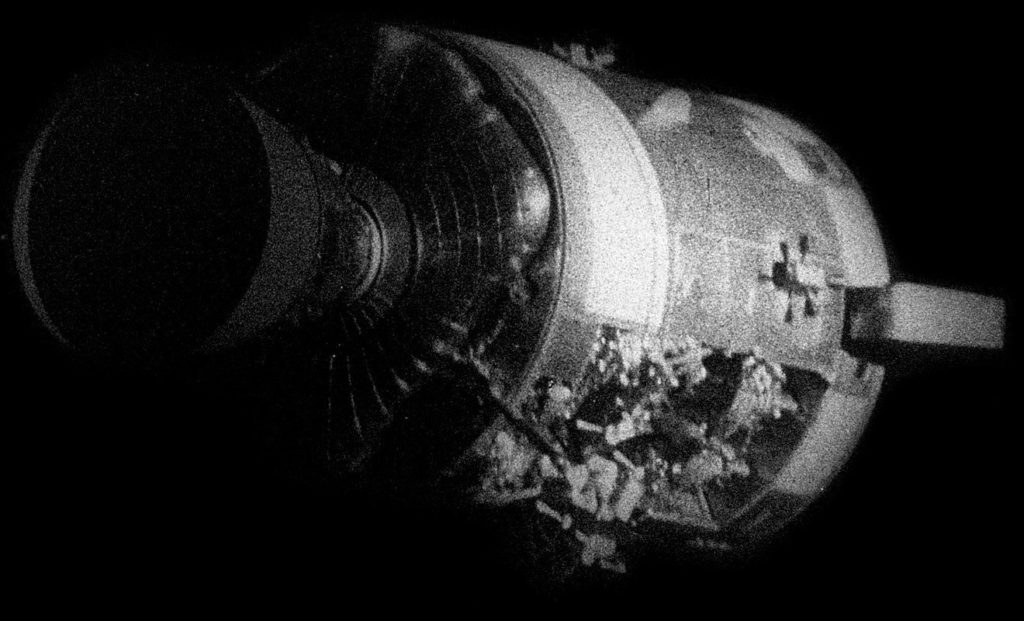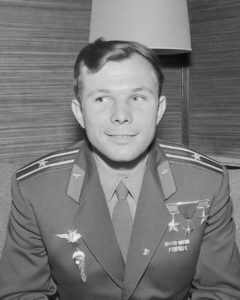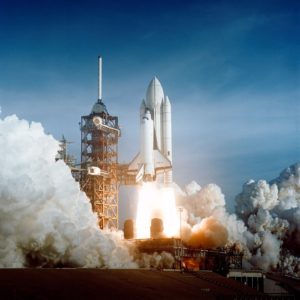
Photo: View of the damaged Apollo 13 Service Module after separation from the main craft | NASA
April 12, 1961: Yuri Gagarin becomes first human being in space

Yuri Gagarin at a press conference in Finland | Finnish Museum of Photography
Yuri Gagarin (1934-1968) was a Soviet pilot and cosmonaut who became the first human to travel into space on April 12, 1961. This achievement by the Soviets was a major milestone in the Space Race between the US and the USSR—at the point in time, only animals had successfully been sent into space. Gagarin completed one orbit around the Earth aboard the Vostok 1 space capsule before safely returning to Earth, 1 hour and 48 minutes after the capsule was launched.
After his successful mission, Gagarin became a national hero in the USSR, earning several medals and titles. The Russian town of Gzhatsk was renamed Gagarin in his honor after his death in 1968.

The Space Shuttle Columbia’s first launch on 04/12/1981 | NASA
April 12, 1981: First launch of the Space Shuttle Columbia
The Space Shuttle Columbia was the first of a series of launches in NASA’s Space Transportation System (STS-1) program, as well as the first fully-functional, manned space shuttle to be launched into space. Columbia lifted off from Kennedy Space Center in Florida on April 12, 1981, with commander John W. Young and pilot Robert Crippen on board. The historic launch occurred 20 years and 1 day after Russian cosmonaught Yuri Gagarin became the first human in space. The Columbia’s first mission lasted 54 hours in all, safely landing at Edwards Air Force Base in California. The Columbia was the first orbiter that was built to be reusable, allowing it to be used for 27 space missions over 22 years before it was destroyed upon re-entry to Earth’s atmosphere on February 1, 2003, resulting in the deaths of all 7 crew members on board.
April 14, 1629: Christiaan Huygens born

Christiaen Huygens II (1629-1695) | signed b.l.: C.Netscher / 1671
Dutch physicist, mathematician, astronomer and inventor Christiaan Huygens (1629–1695) was born in The Hague, Dutch Republic on April 14, 1629. Huygens’s discoveries and inventions are numerous, spanning across several scientific fields. He is noted for his groundbreaking contributions in optics, mechanics, physics, and mathematics. As an inventor, he worked to improve the design of telescopes and clocks; as an astronomer, he is known for his studies of Saturn’s rings and the discovery of its moon Titan. He is also credited for the invention of the pendulum clock, which became the most accurate timekeeping device of his day and remained so for over 300 years.
March 14, 1970: Apollo 13 circles the Moon
Apollo 13 was the seventh crewed mission in NASA’s Apollo Space Program, and the third launched with the intention of landing on the Moon. The Odyssey spacecraft was launched on April 11, 1970, with commander Jim Lovell, command module pilot Jack Swigert, and lunar module pilot Fred Haise aboard. Two days into what was intended to be a three-day mission, a pressure sensor malfunction caused an explosion inside one of the craft’s oxygen tanks, causing significant damage to the craft and rapidly depleting its oxygen, power, and water supplies.

Apollo 13 astronauts (left to right) Haise, Lovell and Swigert wave
to sailors after exiting the recovery helicopter on the USS Iwo Jima | NASA
The Moon landing was aborted and the crew took refuge inside the Aquarius lunar module, still attached to the Odyssey. Instead of landing on the Moon on March 14, 1970, the three astronauts looped around the Moon and traveled back to Earth. Space inside the lunar module was limited, as it was only built to hold two crew members, the temperature dropped as low as 38 degrees Fahrenheit, and the astronauts were forced to ration water and urinate in bags. After four days of uncertainty and discomfort, all three astronauts were safely returned to Earth as they splashed down in the Pacific Ocean after a particularly rough descent through the atmosphere.